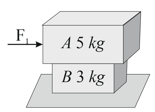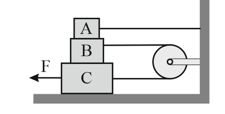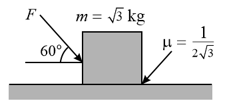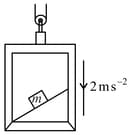Static and Dynamic Friction
Important Questions on Static and Dynamic Friction
Consider on a rough horizontal surface a block is kept. A horizontal force just strong enough to move the block is acting on it, the force is maintained for seconds and then removed. The total distance moved by the box is '' meters. What is the value of ''?
A plank is rotating in a vertical plane about one of its fixed end with a constant angular velocity A block of mass is placed at a distance from end (see figure) which is hinged. The block starts sliding down when the plank makes an angle with the horizontal. If coefficient of friction between the plank and the block is and given that . Find the value of .

If force is applied on the block. Then, frictional force acting on the block will be (in Newton),

A block rests over another block placed over a smooth horizontal surface. There is friction between and . A horizontal force , gradually increasing from zero to a maximum, is applied to , so that the blocks move together without relative motion. Instead of this, another horizontal force , gradually increasing from zero to a maximum, is applied to , so that the blocks move together without relative motion. Then,

and . The coefficient of friction between any two surface is . The pulley is frictionless and the string is massless. is connected to a wall by a massless rigid rod.

A person holding a bag starts sliding freely from a point A on a frictionless inclined plane while his bag starts falling down vertically from the same point. The final speeds of the man and the bag on reaching the ground after falling through the same height should be such that
If a body of mass is moving on a rough horizontal surface of coefficient of kinetic friction , the net electromagnetic force exerted by the surface on the body is
What is the maximum value of the force such that the block shown in the arrangement, does not move?

A block of mass is kept on an inclined plane of a lift moving down with an acceleration of . What should be the coefficient of friction for the block to move down with constant velocity relative to lift? The angle of inclination of the wedge is .

A block of mass is placed over a plank of mass . Plank is placed over a smooth horizontal surface. The coefficient of friction between and is . Block is given a velocity towards the right. Acceleration of relative to is


